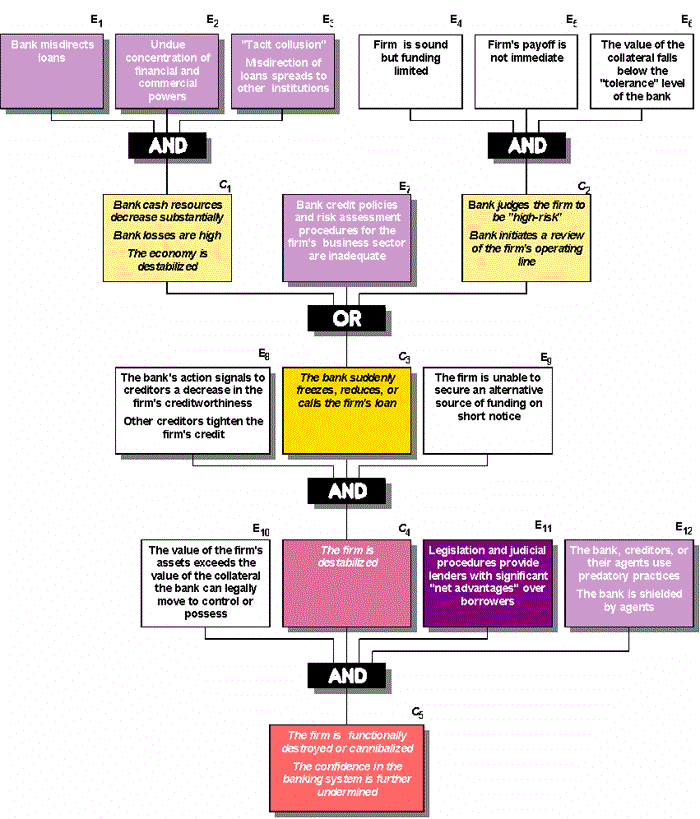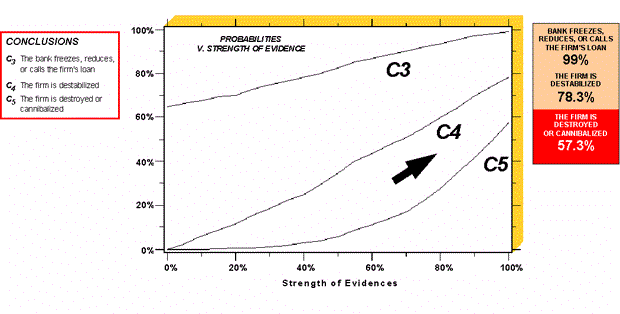CHAPTER 3
Expert System
Objective
The objective of the expert system is to quantify the potential "effects" of
an increasingly Darwinistic business environment on sound but funding-limited
small firms. "Effects" are quantified as changes in the subjective probability
of conclusions, such as, the bank suddenly freezes, reduces, or calls the firm's loan
and sound funding-limited firms are destabilized. "Causes" are quantified
as increases in the subjective probabilities of input evidences, such as, bank loans
are misdirected and the concentration of financial and commercial powers is
excessive.
Expert System Rules
The expert system consists of input evidences, rules, and conclusions.1 Rules connect evidences and conclusions and are expressed in
the form of if-then logic statements. Five rules are considered:
Rule 1:
IF [the bank misdirects loans and indulges in speculative
overinvestments] AND [financial and commercial powers are
concentrated] AND ["conscious parallelism" or
"tacit collusion" in the financial sector spreads the misdirection of loans] THEN [the economy is destabilized and the bank's cash resources fall
substantially]
Rule 2:
IF [the firm is funding limited] AND
[the firm's payoff is not immediate] AND [the value of the
firm's collateral falls below the bank's "tolerance" level (say about 1 to 3
times the value of the firm's loan)] THEN [the bank judges the
firm to be "high-risk"]
Rule 3:
IF [the economy is destabilized and the bank's cash resources
fall substantially] OR [the bank's loan policies and risk
assessment procedures for the firm's business sector are flawed or inadequate] OR [the bank judges the firm to be "risky"] THEN [the bank suddenly freezes, reduces, or calls the firm's loan]
Rule 4:
IF [the bank suddenly freezes, reduces, or calls the firm's
loan] AND [other creditors tighten the firm's credit] AND [the firm is unable to secure an alternative source of funding on
short notice] THEN [the firm is destabilized]
Rule 5:
IF [the firm is destabilized] AND [the
value of the firm's assets exceeds the value of the assets the bank can legally move to
control or possess] AND [the legislation and the judiciary favor
lenders over borrowers] AND [the bank, creditors, or their
agents use predatory practices] THEN [the firm is functionally
destroyed or cannibalized]
The rules governing the expert system are displayed in Plate 3-1.
Input Evidences
The input evidences can be organized around four distinct categories:
Category 1. Distribution of Bank Loans and Concentration of Power:
E1: Evidence
of loan misdirection at banks.
E2: Evidence of
excessive concentration of financial and commercial powers.
E3: Evidence of
"conscious parallelism" or "tacit collusion" in the financial sector.
Category 2. State of the Firm:
E4: Evidence
that the firm is sound and funding limited.
E5: Evidence that
the firm's payoff is not immediate.
E6: Evidence that
the value of the secured collateral held by the bank has fallen below the bank's
"tolerance" level (say about no less than one to three times the value of the
loan).
E9: Evidence that the firm is unable to secure an alternative
source of funding on short notice.
E10: Evidence that
the value of the firm's assets (real, tangible, or intangible assets, including patents,
copyrights, trade marks, R&D tax credits, etc.) exceeds significantly the value of the
secured collateral.
Category 3. Bank Policies and Signaling:
E7: Evidence
of inadequate bank policies and procedures regarding the firm's business sector.
E8: Evidence that
when the bank tightens a company's credit, it signals a decrease in the creditworthiness
of that firm.
Category 4. Legislative and Judicial Bias and Bank Practices:
E11: Evidence
that legislation and the judiciary favor lenders over borrowers.
E12: Evidence that
the bank, creditors, or their agents use adversarial and predatory practices.
The categories can be consolidated into two groups:
Group 1. Firm-Related Inputs:
Firm-related inputs include all Category 2 evidences. The truth of each firm-related
evidence is assigned a subjective probability. Firm-related probabilities are
assumed to be characteristic of a sound but funding-limited firm. The subjective
probability that the firm is funding-limited is set at 100%. The probability that the
firm's payoff is not immediate is set at a subjective 80%, etc. Firm-related probabilities
are held constant.
Group 2. Environment-Related Inputs:
Environment-related inputs include all evidences in Categories 1, 3, and 4. The truth
of each environment-related evidence is assigned a range of subjective
probabilities--from 0% to some maximum subjective
value. Together, the ranges codify the degree to which the business environment is
exploitative, adversarial, or predatory.
To simulate an increasingly "Darwinistic" environment, these probabilities are
varied simultaneously from 0% to their respective subjective maximum values.
Clearly, the higher the maximum values, the greater is the truth that the environment is
exploitative, adversarial, or predatory. For example, the subjective probability that bank
loans are misdirected is varied from 0% (no evidence of misdirection) to 100%. The
subjective probability that bank practices are predatory is varied from 0% (no evidence of
predation) to a maximum of 80%, etc.
To increase in one fell swoop all environment-related probabilities, a parameter called
strength of evidence is used. By increasing this parameter from 0% to 100%, all
environment-related probabilities are increased simultaneously from 0% to their
respective maximum values. The ranges of the subjective probabilities for all the input
evidences used in the Monte Carlo simulation are given in Table 3-1.
Conclusions
The expert system has five conclusions, four intermediate (C1-C4)
and one final (C5):
Intermediate Conclusions:
C1: Cash resources at banks
fall substantially; several business sectors or the whole economy are destabilized.
C2: The bank judges the firm to
be in the "high-risk" category; it initiates a review of the firm's line of
credit.
C3: The bank suddenly and
deliberately freezes, reduces, or calls the firm's loan.
C4: The firm is destabilized.
Final Conclusion:
C5: The firm is
functionally destroyed or cannibalized by economic predators.
The dependence of the subjective probabilities of conclusions
C3,
C4,
and C5 on the strength of the
input evidences is shown in Plate 3-2. The Plate
illustrates very clearly that the subjective probability that a sound funding-limited
firm is destroyed increases substantially as the business environment becomes
increasingly Darwinistic.
|

